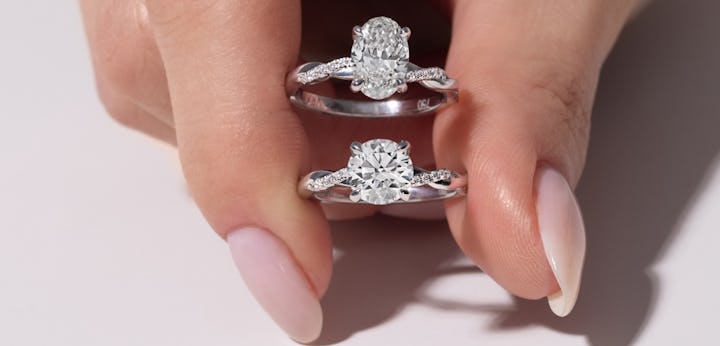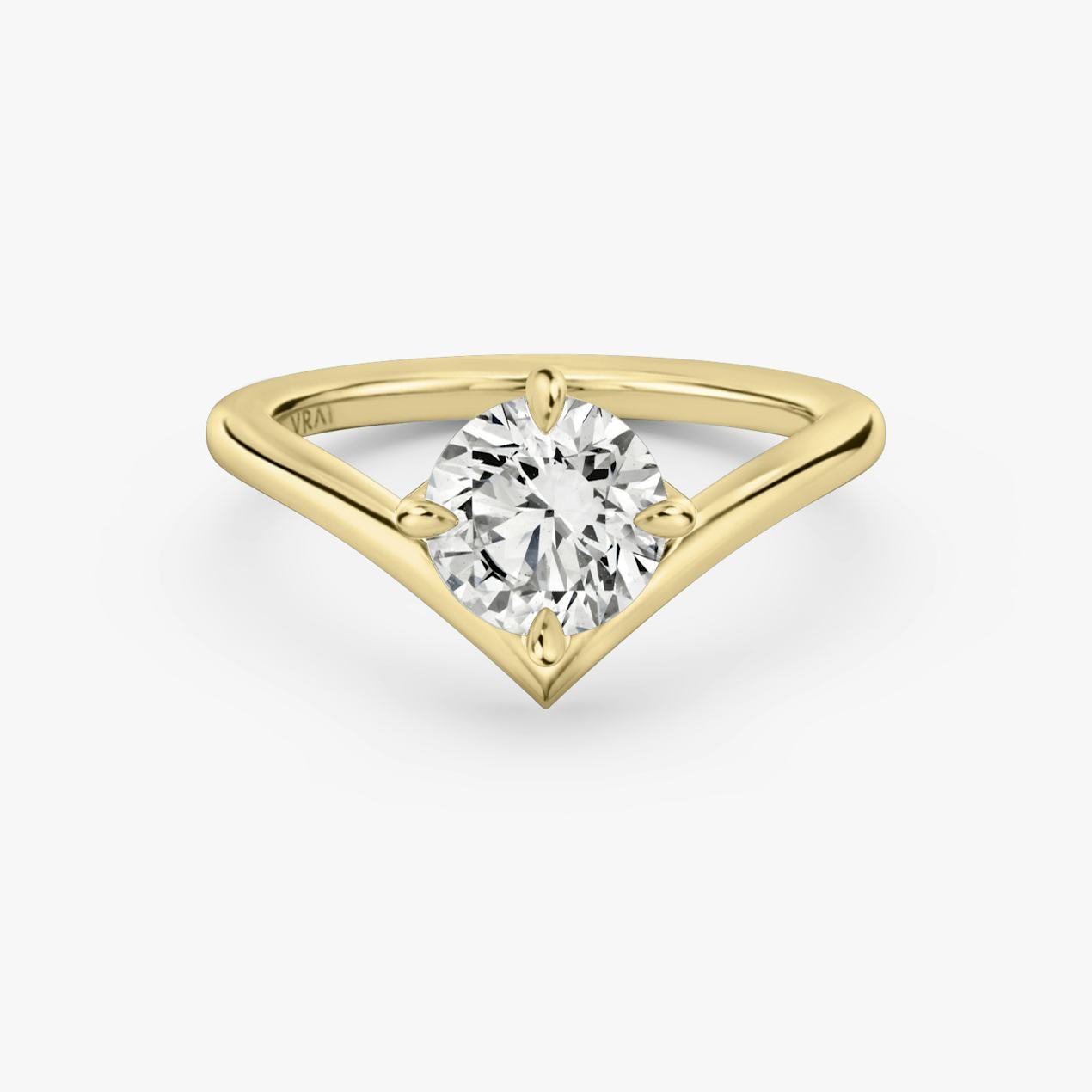

Round vs Oval Engagement Rings: Differences, Similarities, Style Comparisons
Round and Oval diamonds are both brilliant-cut diamonds that have a lot of fire, brightness, and scintillation thanks to their triangle and kite-shaped faceting. Their timeless and classic shapes make them resistant to trends and fads, and their soft curves work great with most ring styles and settings. No wonder they’re the most popular diamond shapes on the market and that it’s quite hard to decide between the two.
Round and Oval VRAI created diamonds are the two best-selling shapes, and they each have their features and characteristics. For the many of you who are on the fence between the two shapes, you can book an appointment with our experts who will explain how either can work for your engagement ring.
What is a Round Cut diamond?
The Round Cut diamond is also known as Round Brilliant Cut diamond. It is by far the most popular diamond cut. It has 57 or 58 facets, depending on whether there’s a culet or not. A standard round brilliant diamond has 33 facets above the girdle and 24 or 25 below the girdle, depending on whether or not there’s a culet.
What is an Oval Cut diamond?
Oval Cut diamonds are similar to Round diamonds but have an oval, elongated shape. They date back to at least 1304, with the famed Koh-i-Noor. Like the round diamond, they have 58 facets. An Oval is a fancy shape that will make your finger longer and slimmer.
Be the first to know
Hear about our latest designs and upcoming events.
Do Round and Oval diamonds have different fire and brilliance?
Both the Round Brilliant cut and the Oval cut are cut in the brilliant style. This means that their faceting consists of triangular and kite-shaped facets, and that, because of that, they exhibit similar fire and brilliance. However, ovals sport the so-called bow tie, dark bow-shaped pattern across the table of the diamond. This phenomenon only occurs in elongated shapes, because of the way the faceting changes in the center of the diamond.
Which Diamond Shape Has the Most Brilliance and Fire?
True, both Round Brilliant and Oval diamonds are both cut in the brilliant style and their fire and brilliance has a few similarities. Intensity-wise, though, they’re not the same. “Nothing sparkles like a round brilliant! Ovals are still brilliant cuts, but the facets will not be as uniform as they are on a round, which means they catch light differently,” says Grace Taylor, VRAI’s Chief of Sales and Customer Experience. “Ovals have smaller facets near the two ends, and wider facets in the center, which can mean their sparkle varies depending on where in the diamond you are looking.”
Which Shape will Look Bigger on My Hand?
Ovals will look substantially bigger on your hand when compared to a Round diamond at the same carat weight. Ovals, with their elongated shape and more shallow pavilion, have a larger surface area that will also make your finger appear slimmer and longer. “The only real drawback of an oval is that if you’re looking for the uniform sparkle of a round, it won’t give that to you,” says Taylor. “They have a larger table facet so they can get smudged more easily which also dulls the sparkle.”
Round vs Oval: Diamond Size Comparisons
The easiest way to get an idea of the difference in terms of surface area is by comparing the sizes of Ovals and Rounds at different carat weights. The reference material is VRAI’s diamond size chart, which contains data from the inventory of VRAI created diamonds. It should also be noted that 2 carats are double the weight of 1 carat, but not double the size. A 2 carat Oval diamond is 1.59 larger than a 1 carat Oval diamond, a 2 carat Round diamond is around 1.55 larger than a 1 carat round diamond.
1 Carat Oval Diamond vs 1 Carat Round
A 1 carat Round Brilliant diamond will measure from 6.4 to 6.6 mm in diameter, while a 1 carat oval will measure from 8.29 by 5.61mm to 8.49 by 5.81mm. The surface area of an Oval diamond is around 30% larger than the area of a Round diamond.
2 Carat Round vs 2 Carat Oval Diamond
A 2 carat Round diamond will measure from 8.07 to 8.27 mm in diameter, while a 2 carat Oval is 10.47 x 7.09mm to 10.67 by 7.29mm. The area of an Oval is 1.47 bigger than the area of a Round diamond.
Oval vs Round: Price Differences
Despite the two shapes’ similarities in terms of cutting and faceting and the Oval’s unique flattering properties, the Round diamond is still more expensive. Let’s take, for the sake of comparisons, a carat G, VS quality VRAI created Round and an Oval with the same specs in the 1 carat range. A 1.19 G, VS2 VRAI created Round diamond will cost $1,538; an Oval with the same weight, color, and clarity will cost $1,319. We can observe a similar pattern at 2 carats. A 2.09 G, VS2 Oval is priced at $2,743; a G, VS2 Round $2,935.
How Will I Know if I Prefer an Oval or a Round Diamond?
People often debate the oval or round when they’re just shopping on their own, or seeing them in photos. “Once you see an oval and a round on your actual hand, it’s a lot easier to make the call on which one you like,” advises Grace Taylor. “You can usually figure out if someone will prefer oval or round long term by asking about what they are looking for most in their diamond - if they say sparkle, it’s round all the way. If they want something classic or traditional, round. If they want finger coverage, it’s oval. If they want something a little more hip/trendy - oval.”
Top 3 Round Engagement Ring Styles

The Three Stone with Pear Side Stones
Combining a Round center diamond with Pear side stones creates a pleasing tapered effect that yields substantial finger coverage without being bulky or overwhelming.

The Signature V
The pointed edges of the V shaped band create a stunning contrast with the harmony and the unprecedented brilliance of the Round Brilliant diamond. Timeless and contemporary, the Signature V is a classic in the making.
Top 3 Oval Engagement Ring Styles

The Oval Three Stone with Trillion Side Stones
A tapered look uniquely suits three-stone rings. Pairing an Oval center stone with Trillion cut side stones creates a game of contrast between curves and edges, but unmatched brilliance and elegant finger coverage.

The Curator
The rounded band balances symmetry and substance and flawlessly complements the finger-lengthening effect of an Oval cut. The compass setting is a detail that emphasizes the elongated shape of an Oval diamond.

The Tapered Classic
With a band that tapers at the head, The Tapered Classic has clean lines that will highlight the slender and elongated proportion of an Oval diamond.
Talk to Our Experts
When debating between Oval and Round engagement rings, customers tend to feel most undecided when they haven’t seen a ring firsthand. By booking an appointment with an expert, you can directly see how each shape complements the features of your hand and your overall personal style.